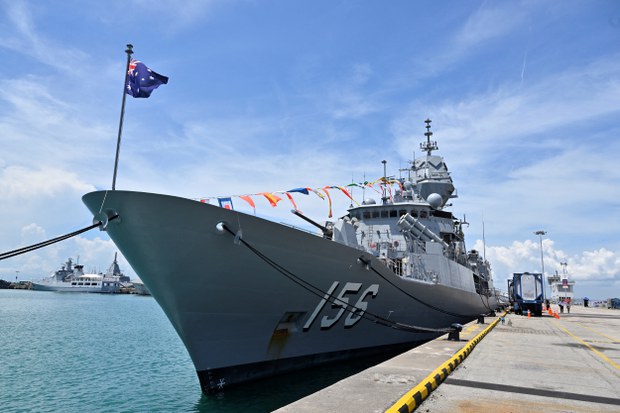China rejects Australia’s accusation of unsafe sea conduct
Share

Royal Australian Navy vessel HMAS Toowoomba is docked at Changi Naval Base at the display of warships during maritime defense exhibition IMDEX Asia 2023 Singapore, May 4, 2023.
Beijing officials have spoken against allegations that a Chinese destroyer operated its sonar device near divers from the Royal Australian Navy’s HMAS Toowoomba, causing them minor injuries.
The denial came after Australia’s Defense Minister Richard Marles said in a statement at the weekend that the “unsafe and unprofessional interaction” with a People’s Liberation Army Navy (PLAN) destroyer occurred in international waters, inside Japan’s exclusive economic zone (EEZ).
Last Tuesday, divers from HMAS Toowoomba were working to clear entangled fishing nets from its propellers when a Chinese warship approached them.
The ANZAC-class frigate had been in the region conducting operations in support of United Nations sanctions enforcement against North Korea.
“At all times, HMAS Toowoomba communicated its intention to conduct diving operations on normal maritime channels, and using internationally recognized signals,” the statement said.
Despite warnings that there were divers in the water, the Chinese vessel still came closer and operated its hull-mounted sonar device, forcing the divers to surface.
Some of them reported minor injuries, “likely due to being subjected to the sonar pulses from the Chinese destroyer.”
The pulses of sound are used for imaging underwater terrain and surrounding objects but they can be dangerous for divers in the water, causing injuries ranging from hearing loss to ruptured internal organs and even brain hemorrhage.
Marles said that his government “has expressed its serious concerns to the Chinese government” and that “Australia expects all countries, including China, to operate their militaries in a professional and safe manner.”
‘Completely untrue’
China’s defense ministry on Monday evening responded to the Australian defense minister’s statement, saying the claims were “completely untrue.”
“China has firmly rejected Australia’s accusations,” said a statement by Chinese defense ministry spokesman Wu Qian.
“China has lodged formal representations with the Australian side.”
According to Wu, the Chinese warship Ningbo (139) was “tracking, monitoring, identifying, and verifying the Australian frigate HMAS Toowoomba in accordance with international laws and regulations.”
“The Chinese vessel maintained a safe distance from the Australian ship and did not engage in any actions that could have interfered with the Australian Navy divers’ operations,” the spokesman added.
Wu also denied that the Chinese vessel had entered Japan’s EEZ as “there is no demarcation between China and Japan in the relevant waters.”
“We urge the Australian side to respect the facts, stop making reckless and irresponsible accusations against China, do more to build up mutual trust between the two sides, and create a positive atmosphere for the sound development of relations between the two countries and two militaries,” he said.
Dangerous encounters
The Chinese military has been accused multiple times of unsafe encounters with military airplanes and warships from the United States and its allies in the East and South China seas.
Earlier this month, Canada said a Chinese J-11 fighter jet launched flares directly in front of a Canadian Royal Air Force CH-148 Cyclone helicopter which was conducting routine exercises in the South China Sea, “putting the safety of all personnel involved at unnecessary risk.”
On Oct. 24, another Chinese J-11 closed within 3 meters (10 feet) of a U.S. Air Force B-52 bomber in a night time intercept over the South China Sea, according to the U.S. Indo-Pacific Command.
The Command released video footage documenting the unsafe intercept of its B-52 bomber which was “lawfully conducting routine operations over the South China Sea in international airspace.”
A week before that, the Department of Defense (DoD) released photos and video clips on Oct. 17 documenting 15 cases of what it called China’s “coercive and risky operational behavior” against U.S. aircraft in the East China and South China seas in the last two years.
The Pentagon said since 2021 China has engaged in more than 180 incidents of “coercive and risky operational behavior” against its assets acting lawfully in international airspace over the East and South China seas.
The number increases to nearly 300 cases if U.S. allied and partner aircraft are included.
The U.S. said China is carrying out “a centralized and concerted campaign” to prevent U.S. forces from operating safely in the air and in the sea.
Beijing has rejected all accusations, in some cases claiming that it was the U.S. who provoked the situations.
Edited by Mike Firn and Taejun Kang.







